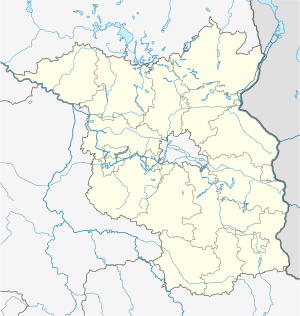Clinker Harbor Bridge
Coordinates: 52 ° 46 ′ 43 ″ N , 13 ° 16 ′ 49 ″ E
| Clinker Harbor Bridge | ||
|---|---|---|
| Listed clinker harbor bridge | ||
| Convicted | Berlin-Karow – Fichtengrund railway line | |
| Subjugated | Oder-Havel Canal | |
| place | Friedrichsthal | |
| Longest span | 60 | |
| completion | 1986 | |
| Status | unused | |
| location | ||
|
|
||
The clinker harbor bridge is a bridge near Oranienburg . The Berlin-Karow-Fichtengrund railway line crosses the Oder-Havel Canal on it . The railway line, which was opened in 1950 and closed in 1999, was primarily used for freight traffic and military purposes and was a relief line for Oranienburg station . The clinker harbor bridge is a steel truss bridge from 1986. It is a listed building as a unique testimony to the history of technology.
location
The bridge is located on the Oder-Havel Canal (canal kilometer 29.665) about one kilometer southeast of the Oranienburg district of Friedrichsthal in the Oberhavel district in Brandenburg . The city of Oranienburg is about three kilometers to the southwest. The single-track Berlin-Karow-Fichtengrund railway (route kilometers 72.1) runs across the bridge in an east-west direction. Immediately to the west of the bridge, the line branches into two branches, which flow into the Berlin Northern Railway at Fichtengrund station about one kilometer west .
history
A railway overpass over the Großschifffahrtsweg in this area has existed since around 1940. During this time, a connecting railway to the Oranienburg brickworks , one of the largest brick-making factories at the time, was built. The brickworks was a branch of the Sachsenhausen concentration camp . Thousands of inmates had to do forced labor at the plant. The northern part of the plant had a port. The name of the bridge is derived from the clinker harbor.
After the end of the war, the plant was dismantled by Soviet troops and the connecting railway was also dismantled. Its route is used by a section of the Berlin-Karow − Fichtengrund railway line, which opened in 1950. The canal was bridged with a Roth-Waagner bridge device with a span of 60 meters.
In the summer of 1986 the bridge was replaced by the new building that exists today.
After 1990 the importance of the railroad for traffic decreased. In 1996 the freight traffic was stopped and the route was closed (with the exception of a few special trips in 1998), in 1999 the route was closed. The tracks in the area of the bridge are still in place.
In 2011 the bridge was placed under a preservation order.
bridge
The bridge is a mobile device of the type "ESB 66", the abbreviation denotes a railway and road bridge with a maximum span of 66 meters . This type had been developed in the GDR under strict secrecy since 1976. The bridge is a two-story construction made of iron framework with a span of 60 meters. Presumably it was developed by the bridge master's office in Dresden, it was manufactured in the steel construction department in Dessau .
In 1982, railway construction groups began testing the bridge device for the first time, which initially only comprised the construction of four fields with a length of 6 m each. In 1983 the full length of the 207 t heavy bridge was built in Walddrehna in the main building of the railway construction team and then dismantled again. The bridge device was then stored.
In the summer of 1986, the previous temporary bridge at the Klinkerhafen, which was only passable at 10 km / h, was replaced by the railway construction teams during a line closure for several months. The ESB-66 bridge was built here with a length of only 60 m and was floated in on July 23, 1986. It was approved for 60 km / h and should be subjected to long-term testing.
The bridge is the only completed project of its kind. There is a footpath on the south side of the bridge that is currently closed (as of May 2015).
The ESB 66 is presumably a further development of the SE bridges . In contrast to these, it has knot screws that run lengthways rather than transversely to the beam axis and welded knots.
Web links
Individual evidence
- ↑ a b c d Jörg Raach, Matthias Baxmann, Fascination Railway. Railway culture in Brandenburg , L + H Verlag, Berlin 2013, ISBN 978-39396-2921-4 , pp. 105-106.
- ↑ a b Entry in the monument database of the State of Brandenburg.
- ^ Peter Bley: DDR-Reichsbahn and "Preparation", VBN Verlag Bernd Neddermeyer, Berlin 2005, ISBN 978-3933254627 , pp. 65–67



